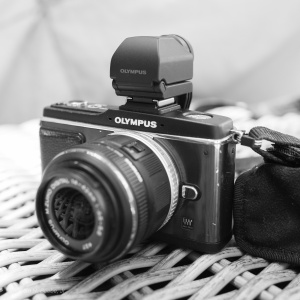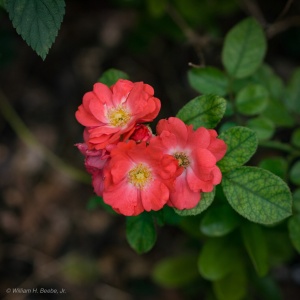
Warning: I’m going to write a meandering post about my photography, and throw up some examples of my photography from a ten year old Olympus digital camera. These will be recent images (as in taken the day this post was written).

But first, this observation: There are no bad cameras anymore, only bad photographers. And it’s been that way now for quite some time, going back ten years. Funny that.
The Olympus camera I’m using in this post is my very first micro four thirds camera, the Olympus E-P2. It was Olympus’ second camera in this format, an immediate follow-on to the E-P1, both of which were introduced in 2009. I purchased my E-P2 copy Christmas of 2009 and paid full price for it, or US $1,200. I don’t normally pay full price for anything photographic, preferring either used, refurbed, or heavily discounted (which means trailing edge by quite a margin). But this time I bought the camera nearly new because I felt it was an important revolutionary step in photography, and I wanted to be a part of that. I also purchased the M.Zuiko 45mm f/1.8 and 17mm f/2.8 to go along with it. That 17mm has long since passed on, replaced with the 17mm f/1.8 and f/1.2 PRO, but the 45mm is still in my kit and still gets used. The E-P2 came with the original 14-42 collapsible kit lens, which was pretty good. But I replaced it with the second generation of that lens; truth be told I wish I still had the original, if for no other reason than the original had a metal mount while the later generations were plastic.
Over the years I’ve picked up a number of Olympus Pens, as well as the original OM-D E-M5. Later I picked up a Pen F, then a GH4, then a G9. Those last three in particular were heavily discounted from their original release MSRP.
So what can I say about the later generations? You can see significant improvement in the handling of the cameras, and in certain corner cases you can see significant improvement in the sensor and image processors of the cameras. But all of the cameras will take excellent photographs given enough careful forethought to composition and subject matter, even the E-P2. Over the last ten years, Olympus has made one excellent camera after another, as has Panasonic and Sony and Nikon and Canon. There are no bad cameras, only bad photographers.
If I’ve done anything wrong with my pursuit of photography it’s that I’ve purchased too much equipment for not very good reasons. Buying equipment at a discount can only carry you so far. It can be fairly argued that some of it should never have been purchased at all. If I were to sell any of it, I would sell the most recent acquisitions and keep the E-P2 and the pair of E-M5s I have.
Just for the record, the E-P2 has a modest 12MP sensor. Before you laugh, keep in mind that the highly successful Nikon D3 and D700 cameras were introduced with 12MP sensors. I will grant that the Nikons are both 35mm frame sized sensors (what the marketing people like to call “full frame” even though 35mm film cameras were for a long time labeled as miniature format). In spite of the fact that the micro four thirds sensor is only half the diagonal length of 35mm (hence the doubling of a micro four thirds focal length to compare with 35mm: i.e. my 45mm lens is the focal length equivalent of a 90mm on one of those Nikons), 12 MP is still 12MP, and with the right lens in front of the sensor and photographing in normal light (i.e. not in such dark environs you really can’t see much), you can’t tell them apart unless you know in advance which was used to make a given photograph.
My E-M5s have 16MP sensors, and the Pen F and G9 have 20MP sensors. Can I tell photos apart with those cameras? Sometimes. Do the later cameras handle much better, much faster than the E-P2? Absolutely. But the E-P2, under the right circumstances and with a photographer that understands how to handle it, will still produce excellent work. All those cameras will.




Nice pics. The only way I get good pictures is by taking a lot of pictures and sorting through them.
LikeLike
Thank you. Shooting many photos and then self-curating to find the best is normal.
LikeLiked by 1 person
I bought a M43 in 2012, when my son was born. Going from APSC to M43, I remember being so excited about the size of the lenses, and the idea that my 45mm 1.8 was so portable. I also remember the disappointment when I realized that a 45mm 1.8 wouldn’t give me the same results as my Canon 50mm 1.8.
I think Marketing people, whether it’s for M43 or for APSC, brought a lot of confusion in the debate of sensor equivalence. And looking at forums like dpreview, I believe it’s still the case today.
Now that I have a better grasp on photo technicalities, I agree with you, there aren’t any bad cameras anymore. But it took me a while to get to that conclusion :)
LikeLike
Ah, yes. Sensor equivalency. So, let me indulge in a bit of that. The M.Zuiko 45mm is the equivalent of a 90mm lens on a 35mm camera. Wide open at f/1.8, that 45mm lens gives a depth of field equivalent to f3.6 on that 90mm. In short, on your 35mm camera you would have purchased a 90mm f/3.5, which back in the day would have been an affordable lens to purchase. And there’s nothing wrong with that. The reason it looks like I’m multiplying values by 2 is because the diagonal length of a micro four thirds sensor is 1/2 that of a 24mm by 36mm “full frame” sensor.
Unfortunately the majority of today’s camera users obsess over maximum apertures, maximum sensor sizes, and maximum pixel counts. And it’s all tribal, a zero-sum game with them. It’s always about the numbers, never about the use of the equipment in the service of art. And I don’t mean high-brow Art, I mean work-a-day art of day-to-day living. All those moments special to you, whatever they happen to be.
As far as Marketing is concerned, as far as they’re concerned they’ll say or do just about anything to get the next sale. The great irony is to call 35mm sized sensors Full Frame, when for nearly the entirety of the 20th century 35mm was considered miniature format compared to larger film formats, such as medium (6mm x 6mm, 6mm x 7mm) or even larger film formats, such as 4×5 inch or even 8×10 inch.
LikeLiked by 1 person
Yes, I’ve been doing my homework since I bought my GX1 and I think I have a pretty good grasp about equivalences. I agree with what you mentioned, but a lot of people are still very confused about how these equivalences work. A quick search on Youtube and the countless videos on FF vs. Crop Sensor can show that.
Ultimately, I think what matters is having a good understanding of what the tools you’re using are capable of so, you can tackle the job at hand properly.
And I’ll be honest, I went through a “shoot everything wide open” period too, but I think it’s part of the journey to sometime obsess over optical tricks until you understand when it’s appropriate to use them.
Thanks for taking the time to write a long comment, I appreciate :)
LikeLike